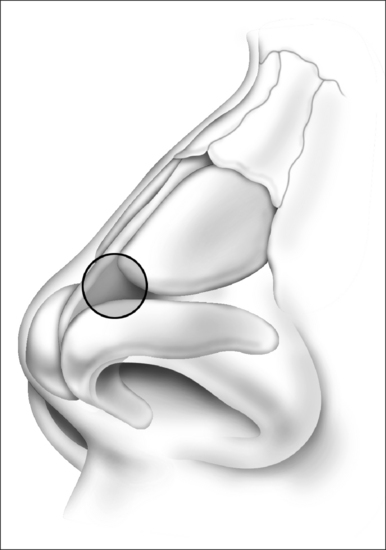Chapter 21 Correction of nasal obstruction due to nasal valve collapse
1 INTRODUCTION
Airway obstruction or difficulty breathing through the nose is one of the most frequent complaints presented to an otolaryngologist. Nasal septal deviation and turbinate hypertrophy are easily identified as areas of anatomic obstruction. One area that can be overlooked as an etiology for obstruction is an incompetent nasal valve. Nasal valve obstruction can markedly reduce airflow through the anterior nostril. This reduction in flow can contribute to snoring. A patient who complains of snoring is indicating that something more serious may be occurring. Snoring can present as a symptom of obstructive sleep apnea. Many people who snore also admit to excessive daytime sleepiness and fatigue.1
The internal valve is the area in which the septum articulates with the lower border of the upper lateral cartilage (Fig. 21.1A). The angle of this area is normally 10° to 15°. Minimal reduction in this angle can substantially restrict nasal airflow. The external nasal valve is an area composed of the alar or lower lateral cartilage with its associated cutaneous support as a mobile alar wall (Fig. 21.1B). It is bordered superiorly by the caudal edge of the upper lateral cartilages, inferiorly by the nasal floor, and posteriorly by the inferior turbinate. Laterally it is supported by the pyriform aperture of the maxilla and fibrofatty tissue of the ala.2
In consideration of surgical approaches to correct nasal obstruction, all possible causes must be entertained. Correction of septal deviation alone may not alleviate obstruction. Valvular effects may equal or surpass a deviation of the septum as the cause of airflow obstruction. In an excellent study by Constantain it was shown that septoplasty in addition to internal and external valve reconstruction offered the best relief in nasal obstruction. This combined approach offered significantly improved airflow in comparison to septoplasty alone.3
2 EXAMINATION
Examination before and after the application of topical vasoconstrictors can allow the effects of turbinate hyperplasia to be evaluated. The use of a standard nasal speculum spreads the valve open and can allow a narrowed valve to go undetected. An otoscope is a useful tool to evaluate internal valve collapse as it dose not splay open the area of concern. Some advocate the use of a Q-tip or cerumen spoon to elevate the sidewall of the nose 1–2 mm. If the patient reports improved breathing with this conservative maneuver, valve restriction is contributing to the patient’s obstruction.4 It is important to evaluate the competence of both the internal and the external nasal valves as concurrent correction is often required in order to alleviate the symptoms of nasal obstruction.
3 SURGICAL APPROACHES
3.1 INTERNAL NASAL VALVE
The spreader graft as described by Sheen in 19845 has been the most common approach to correct internal nasal valve collapse. Several adaptations to this technique have been reported in the literature.6–9 Each offers a varying twist of the standard that may accommodate specific circumstances pertaining to individual patients. An open approach is preferable as it allows superior visualization of anatomy.
3.1.1 TECHNIQUES FOR INTERNAL VALVE REPAIR
Spreader graft
< div class='tao-gold-member'>
Stay updated, free dental videos. Join our Telegram channel

VIDEdental - Online dental courses




